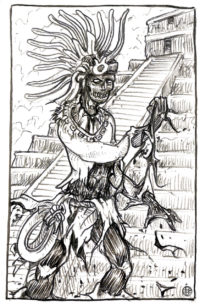“The annual festival of Xipe
Totec was celebrated on the spring equinox before the onset of the rainy
season; it was known as Tlacaxipehualiztli. This festival took place in
March at the time of the Spanish Conquest. Forty days before the
festival of Xipe Totec, an Indian slave who was captured at war was
dressed to represent the living god who was honored during this period.
This occurred in every ward of the city, which resulted in multiple
Indians being selected. The central ritual act of "Tlacaxipehualiztli”
was the gladiatorial sacrifice of war prisoners, which both began and
culminated the festival. On the next day of the festival, the game of
canes was performed in the manner of two bands. The first band were
those who took the part of Xipe Totec and went dressed in the skins of
the war prisoners who were killed the previous day, so the fresh blood
was still flowing. The opposing band was composed of daring soldiers who
were brave and fearless, and who took part in the combat with the
others. After the conclusion of this game, those who wore the human
skins went around throughout the whole town, entering houses and
demanding that those in the houses give them some alms or gifts for the
love of Xipe Totec. While in the houses, they sat down on sheaves of
tzapote leaves and put on necklaces which were made of ears of corn and
flowers. They had them put on garlands and give them pulque to drink,
which was their wine. Annually, slaves or captives were selected as
sacrifices to Xipe Totec. After having the heart cut out, the body was
carefully flayed to produce a nearly whole skin which was then worn by
the priests for twenty days during the fertility rituals that followed
the sacrifice. This act of putting on new skin was a ceremony called
‘Neteotquiliztli’ translating to “impersonation of a god”. The skins
were often adorned with bright feathers and gold jewellery when worn.
During the festival, victorious warriors wearing flayed skins carried
out mock skirmishes throughout Tenochtitlan, they passed through the
city begging alms and blessed whoever gave them food or other offerings.
When the twenty-day festival was over, the flayed skins were removed
and stored in special containers with tight-fitting lids designed to
stop the stench of putrefaction from escaping. These containers were
then stored in a chamber beneath the temple.“
– Annual festival of Tlacaxipehualiztli, Wikipedia.
Sometimes reality is creepier than fiction.
Pencil doodle on A6 sketchbook from my Great Old Ones & Their Kin series for an upcoming Elder Gods Tarot project
